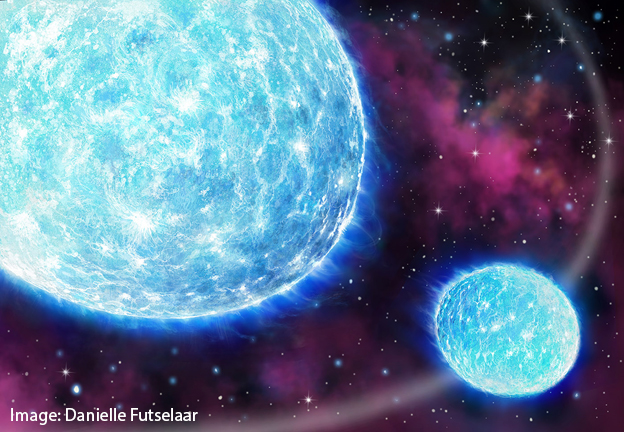Iota Orionis: pulsating beacon of a constellation
 Using the world’s smallest astronomical satellites, researchers detect the biggest stellar heartbeat ever
Using the world’s smallest astronomical satellites, researchers detect the biggest stellar heartbeat ever
MONTREAL, March 8, 2017 – Astronomers from the BRITE (BRight Target Explorer) Constellation project and Ritter Observatory have discovered a repeating one-per-cent spike in the light of a very massive star which could change our understanding of such stars. Iota Orionis is a binary star system and is easily visible with the naked eye, being the brightest star in the constellation Orion’s sword. Its unique variability, reported in the journal Monthly Notices of the Royal Astronomical Society, was discovered using the world’s smallest astronomical space satellites, referred to as “nanosats”. “As the first functional nanosatellite astronomy mission, the BRITE-Constellation is at the vanguard of this coming space revolution,” said Canadian BRITE-Constellation principal investigator Gregg Wade, of Royal Military College of Canada, Ont.
The light from Iota Orionis is relatively stable 90 per cent of the time but then dips rapidly followed by a large spike. “The variations look strikingly similar to an electrocardiogram showing the sinus rhythms of the heart, and are known as heartbeat systems,” said Herbert Pablo, the project’s principal investigator, a post-doctoral researcher at Université de Montréal and member of the Centre for Research in Astrophysics of Quebec (CRAQ). This unusual variation is the result of the interaction of two stars in a highly elliptical 30-day orbit around each other.
While the two stars spend the majority of their time far apart, they do come nearly eight times closer together for a short time once every orbit. At that point the gravitational force between the two stars becomes so strong that it rapidly distorts their shapes, like pulling on the end of a balloon, causing the unusual changes in light. Iota Orionis represents the first time this effect has been seen in such a massive system (35 times the mass of the Sun), an order of magnitude larger than any in previously known systems, and allows for direct determination of the masses and radii of the components.
A shaking star is like an open book
Even more interesting is that these systems allow us to peer inside the stars themselves. “The intense gravitational force between the stars as they move closer together triggers quakes in the star, allowing us to probe the star’s inner workings, just as we do for the Earth’s interior during Earthquakes,” said Pablo. The phenomenon of quakes is very rare in massive stars in general and this is the first time induced quakes have ever been seen in a star this massive, let alone one whose mass and radius are known. These unprecedented quakes have also led to the first real clues to how such stars will evolve.
Astronomers are hopeful that this discovery will provide the initiative to search for other such systems, creating a fundamental shift in how we study the evolution of massive stars. This is important, since massive stars are laboratories of elements essential to human life.
About the BRITE-Constellation: http://www.brite-constellation.at/
About the study
Herbert Pablo, N. D. Richardson, J. Fuller, J. Rowe, A.F.J. Moffat, R. Kuschnig, A. Popowicz, G. Handler, C. Neiner, A. Pigulski, G. A. Wade, W. Weiss, B. Buysschaert, T. Ramiaramanantsoa, A. D. Bratcher, C. J. Gerhartz, J. J. Greco, K. Hardegree-Ullman, L. Lembryk, W. L. Oswald; The Most Massive Heartbeat: An In-depth Analysis of ι Orionis. Monthly Notices of the Royal Astronomical Society (Oxford University Press): http://doi.org/10.1093/mnras/stx207
The study was supported by grants from the Natural Science and Engineering Research Council of Canada; le Fonds de recherche Nature et technologies du Québec; the National Science Centre (Poland, Narodowe Centrum Nauki ), the National Science Foundation (USA); and the Lee DuBridge Fellowship at Caltech (USA).
Source:
Robert Lamontagne
Public outreach
Center for Research in Astrophysics of Quebec
Phone : (514) 343-6111 ext. 3195
lamont@astro.umontreal.ca
